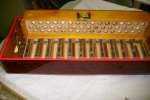Not good news, but not necessarily a disaster either.
The reed plates that are loose (missing wax) need to be rewaxed. I don't know how hard it is to get accordion wax where you are.
To remove the bellows from the bass side you probably need to unscrew it using the screws visible along the edge.
Removing the reed blocks is quite tricky when the register mechanism goes inside the reed blocks. Time for a really skilled repairman.
You can try to pour a bit of glue in the crack in the reed block but only a little bit because you do not want it ending up anywhere near the register mechanism. The bad sound mostly (or completely) does not come from the crack in the reed block but comes from the reed plates not being waxed properly to the block. You should try to rewax the reed plates first and check whether there is still anything wrong with the sound.
I have seen damage on accordions (happens when professionals travel a lot, especially after air travel) and nothing really affected the sound. The only thing that affected the sound is when a reed plate is loose.
The reed plates that are loose (missing wax) need to be rewaxed. I don't know how hard it is to get accordion wax where you are.
To remove the bellows from the bass side you probably need to unscrew it using the screws visible along the edge.
Removing the reed blocks is quite tricky when the register mechanism goes inside the reed blocks. Time for a really skilled repairman.
You can try to pour a bit of glue in the crack in the reed block but only a little bit because you do not want it ending up anywhere near the register mechanism. The bad sound mostly (or completely) does not come from the crack in the reed block but comes from the reed plates not being waxed properly to the block. You should try to rewax the reed plates first and check whether there is still anything wrong with the sound.
I have seen damage on accordions (happens when professionals travel a lot, especially after air travel) and nothing really affected the sound. The only thing that affected the sound is when a reed plate is loose.





